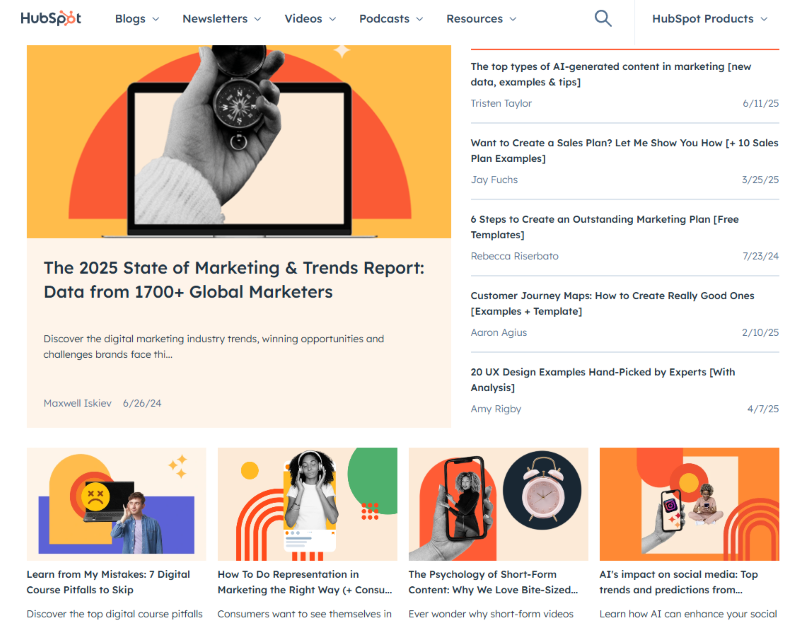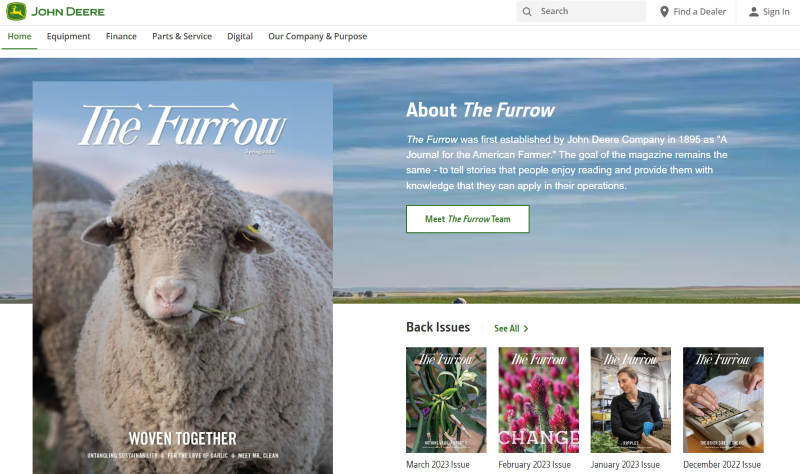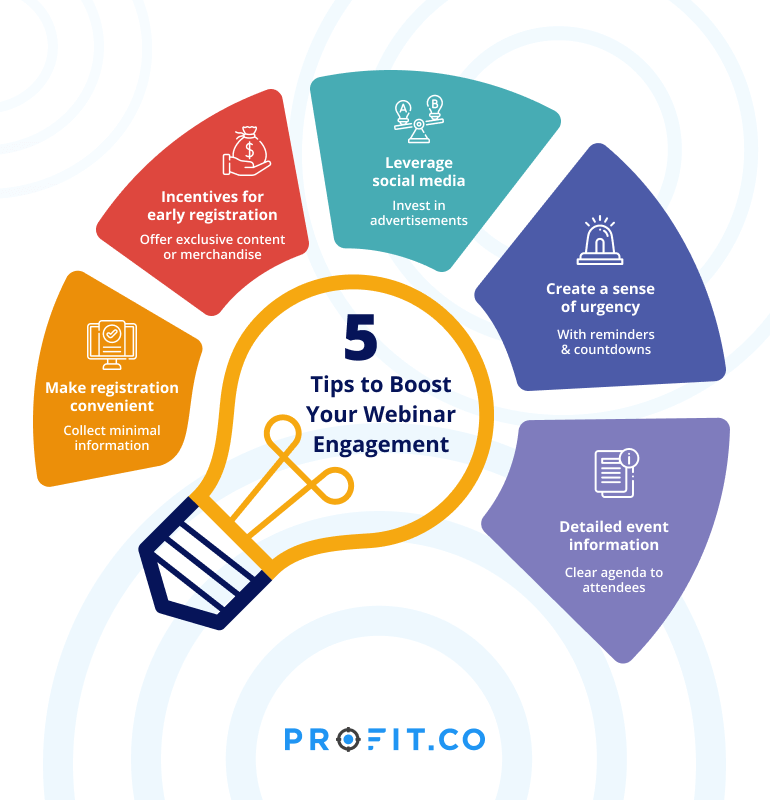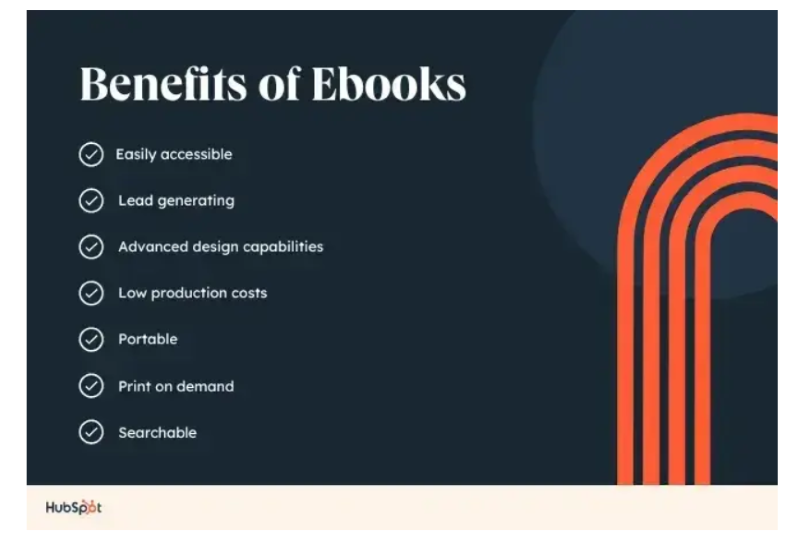Content marketing is the practice of using valuable, audience-driven content to build trust, guide buying decisions, and generate long-term business growth without relying solely on paid promotions.
It’s not just about publishing information. It’s about creating strategic, purpose-driven content that speaks to your customers’ needs at every stage of their journey.
In my experience as a Fractional CMO, content marketing isn’t just a trendy tactic. It’s a proven strategy for building relationships that lead to meaningful business results. It connects brands and buyers by solving problems, sharing insights, and building trust. With the right content, your marketing becomes a consistent and scalable way to generate leads and foster long-term customer loyalty.
In this post, I’ll break down what content marketing really means, how it works, and how you can start using it effectively in your business.
What Are the Benefits of Content Marketing? (And Why It Works Long-Term)
Understanding the definition of content marketing is just the starting point — the real power lies in what it can do for your business. From driving organic traffic to building trust and establishing authority, the benefits of content marketing are both immediate and long-term. Here’s a breakdown of the most impactful advantages, and why content should be at the heart of your digital marketing strategy.
Shape Your Brand Narrative and Control the Conversation
Content marketing gives you the ability to guide how people perceive your business. Instead of leaving your reputation up to online reviews or your competitors, you can create content that communicates your brand values, voice, and unique perspective — consistently and on your terms.
Establish Authority and Thought Leadership
Publishing high-value content (especially blog posts, guides, or opinion pieces) positions your company as an industry leader — and your executives as trusted voices. This is especially critical in the B2B space, where credibility and trust are major drivers of sales.
Improve SEO and Organic Rankings
Content marketing fuels your search engine optimization. Every blog post, FAQ, or how-to guide gives Google more content to index — and more keywords to rank for. The more quality, optimized content you create, the more likely your site will appear in search results that drive qualified traffic.
➡️ Learn how to use content to improve your SEO strategy
Increase Website Traffic and Generate More Leads
Quality content attracts more visitors to your site — whether they find you through search, social media, or shared links. You can turn that traffic into leads by including calls-to-action (CTAs), lead magnets, or email opt-ins throughout your content.
➡️ Explore how to create content that generates sales-ready leads
Educate Your Customers and Guide Purchase Decisions
Helpful content like product comparisons, tutorials, or how-to articles helps prospective buyers understand what you offer — and why it’s right for them. This type of content builds trust and reduces friction in the sales process, especially for complex or high-ticket products.
Build Customer Loyalty and Retention
Content isn’t just for attracting new customers — it’s a powerful tool for deepening existing relationships. From newsletters to member-only webinars to post-purchase guides, consistent content keeps your brand top of mind and reinforces loyalty.
Reduce Dependency on Paid Ads
One of the most underrated benefits of content marketing? It compounds over time. Unlike paid advertising, where traffic stops when your budget does, a strong library of evergreen content keeps working for you long after it’s published — driving traffic, leads, and sales 24/7.
Is Content Marketing Worth It? Here’s What the Latest Statistics Say
If you’re wondering whether content marketing delivers real business results, the data speaks for itself. From increased lead generation to improved customer trust, content continues to outperform traditional marketing tactics in both cost-efficiency and impact.
Here are the latest insights that prove just how powerful content marketing can be:
- Content marketing generates 3X more leads than traditional marketing — while costing 62% less on average. (Source: Demand Metric)
- 73% of B2B marketers say content marketing helps generate higher-quality leads. (Source: Content Marketing Institute, 2024)
- Consumers are 131% more likely to buy from brands that provide educational content. Content doesn’t just inform — it drives purchasing decisions. (Source: Conductor)
- 90% of marketers using content marketing say it builds brand trust, which is more important than ever in today’s skeptical buyer landscape. (Source: Edelman Trust Barometer)
- 52% of businesses use content marketing to build customer loyalty, showing that it’s not just about the first sale — it’s about lifetime value. (Source: Statista)
- 75% of marketers increased investment in branded content in the past year, reflecting growing confidence in long-term ROI. (Source: HubSpot State of Marketing Report 2024)
- Video and blog content are now the top-performing content types for B2B and B2C audiences alike, thanks to higher engagement and conversion rates. (Source: Wyzowl, Semrush)
The takeaway? Whether you’re building brand awareness, nurturing leads, or closing deals, content marketing remains one of the most effective and sustainable strategies available — when done right.
Real Examples of Content Marketing That Work
To truly understand the power of content marketing, it helps to look at how real brands are using it to attract, engage, and convert their audiences. These examples highlight proven strategies that you can adapt for your own business, no matter your size or industry.
Red Bull
Red Bull is a brand that frequently associates itself with pushing boundaries. Content creation has become something of a unique challenge for the brand, as it relies on developing brand awareness centered around extreme behavior and innovation.
This was particularly apparent during the social media and marketing campaign Red Bull put on with Felix Baumgartner, a skydiver. As case studies show, this was an enormously successful social media campaign, because it paired two entities with potentially similar target audiences, and bolstered customer action.
By sponsoring the creation of a new world record, Red Bull established itself as a brand that promotes an active and thrilling lifestyle–a marketing strategy that continues to this day.
HubSpot

HubSpot has made a name for itself by focusing on blogging and SEO. The HubSpot target audience is broad, ranging from business professionals to influencers, to writing professionals in need of some inspiration. The content types most frequently credited with helping HubSpot’s success include blogs and even landing pages, as these all reaffirm the company’s position as a leader in the industry.
HubSpot’s content marketing works well because the brand both targets search engines and shows how to target search engines. Its effectiveness shows in its ability to continually show up and rank highly in search queries, effectively demonstrating how well its content formats actually work. Each time a blog post ranks highly or shows up in search, it is reaffirming how effective HubSpot’s keyword research, SEO practices, and blog post writing truly are.
The HubSpot editorial calendar is so effective because it demonstrates how to use inbound marketing effectively, while actively using the skills it details in its content. In essence, HubSpot practices what it preaches, and shows customers how valuable it truly is.
Overwhelmed by Digital Marketing?
Just released: my new book to help small businesses, entrepreneurs, and marketers master digital marketing in today’s digital-first world.
Drawing on my Fractional CMO experience, Digital Threads simplifies complex strategies into clear, actionable steps for success.
Transform your business today—grab your copy! Click the cover or button below to buy on Amazon.


John Deere’s “The Furrow”


John Deere is nearly synonymous with tractors and farming. That being said, however, there was plenty more for the brand to do to tackle B2B marketing. In one particular piece from the John Deere content calendar, John Deere proved its ability to speak to businesses and ultimately drive results–long before social media marketing was on the scene.
While many a marketing funnel will focus on advertising to consumers (and John Deere certainly opts for those distribution channels), in one campaign, John Deere’s content plan focused specifically on catering to brands. The campaign, called “The Furrow,” was simple: provide value to farmers.
“The Furrow” was a publication that began in 1895, and provided valuable information to farmers. Published and sponsored by John Deere, the publication was not a series of sales adverts; instead, it offered farmers value in the form of information and articles. It effectively established John Deere as a powerful brand, and helped build brand loyalty without incurring huge content marketing costs.
GoPro
The GoPro does interactive content in a way that countless brands can learn from. GoPros came on the scene as an innovative and highly unique product, and they established a brand identity quickly. One of the most powerful ways that GoPro jumped headfirst into content personalization was through user-generated content and leveraging UGC for marketing.
GoPro continually affirms customer relationships and encourages customer engagement by prompting and utilizing UGC to demonstrate the value of the product. The ideal customer for GoPro is a customer who embraces life and goes after their goals; by using UGC, GoPro can establish their brand voice as one that uplifts and highlights people whose lifestyle matches GoPro values.
GoPro’s ongoing campaigns using UGC continually foster customer relationships while developing content marketing materials directly through existing customers and their social media engagement, effectively boosting sales while building audience engagement.
Dove
Dove’s digital content marketing differs from many other content marketing techniques I have identified here, as they focus on emotional storytelling. Dove is perhaps most well known for its “self-esteem project,” or ongoing campaigns to address self esteem and issues in advertising. From influencer marketing to dedicated, standard campaigns, Dove has a finger on the pulse of emotional storytelling in marketing.
Dove’s content pieces that focus on self-esteem only peripherally discuss the brand itself. By using this overarching campaign to promote Dove products, Dove encourages organic social media content from Dove users and builds brand trust and loyalty.
Types of Content Marketing (And How to Choose the Right Ones)
Content marketing isn’t just about writing blog posts and hoping they rank. Today, there are countless formats to choose from — each with unique strengths, use cases, and ways they serve your business goals. The most successful strategies blend multiple types of content to meet your audience wherever they are in their journey.
Here’s a breakdown of the most effective content marketing formats and how they support brand growth:
Blog Posts
Still one of the most powerful tools for SEO and inbound traffic. Blog posts let you demonstrate expertise, rank for keywords, and create content assets that compound in value over time.
➡️ Learn how to create a blog content strategy that drives traffic and conversions
Video Content (YouTube, Shorts, Reels)
Video content is engaging, emotional, and highly shareable. Whether you’re publishing full-length YouTube tutorials or 60-second Reels on Instagram, video helps build connection and brand recognition fast.
➡️ See how video marketing can elevate your social media strategy
Podcasts
Podcasts are ideal for building deep relationships with your audience. They allow you to share insights, tell stories, and feature expert guests — all while keeping your brand in your listener’s earbuds during workouts, commutes, or lunch breaks.
Webinars


Webinars are high-impact tools for lead generation and mid-funnel engagement. They’re great for showcasing your product or expertise in real time while allowing for Q&A and audience interaction.
Infographics
Visual storytelling helps explain complex concepts and statistics in a format people actually enjoy consuming and sharing. Great for link-building, presentations, and social media content.
Email Campaigns
Email remains one of the highest-ROI marketing channels. Use it for nurturing, onboarding, event promotion, or delivering exclusive content. It’s your direct line to the audience that’s opted in to hear from you.
➡️ Explore my favorite email marketing tools
Social Media Content
Social platforms like LinkedIn, Instagram, and TikTok are great for creating awareness and sparking conversation. Short-form posts, carousels, Stories, polls, and memes all help bring your brand to life.
➡️ Learn how to create a social media content calendar that converts
eBooks / Whitepapers


These long-form assets are perfect for lead generation and in-depth education. They allow you to build authority on complex topics while offering valuable gated content in exchange for email addresses.
User-Generated Content (UGC)
Encouraging your customers to create content for you builds trust, boosts engagement, and reinforces social proof. Think testimonials, tagged Instagram photos, customer reviews, or video unboxings.
➡️ Get inspired by these user-generated content campaigns
Which Types Should You Use?
It depends on your audience, resources, and objectives. Blog posts and SEO content are great for discoverability. Videos and webinars drive engagement. Email and whitepapers convert. The key is to mix formats and repurpose content to maximize your reach and ROI.
Content Marketing Across the Customer Journey
One of the most powerful aspects of content marketing is its ability to meet your audience exactly where they are in their buying journey. From creating brand awareness to driving conversions and building long-term loyalty, the right content, delivered at the right time, can move your audience through every stage of the funnel.
Awareness: Make the First Impression Count
At this stage, your audience may not even know they have a problem, let alone that your solution exists. Content should be educational, helpful, and free of any hard sell. Think blog posts that answer common questions, social content that starts conversations, or YouTube videos that teach and inspire. This is where trust begins.
Consideration: Build Authority and Trust
Now that your audience is aware of the problem—and your brand—your content should help them evaluate their options. Case studies, how-to guides, comparison posts, lead magnets, and even webinars can provide the depth and credibility people need to see you as the expert worth listening to.
Decision: Convert with Confidence
When someone’s ready to buy, your content needs to remove doubt and lower friction. This is where testimonials, product demos, detailed FAQs, and ROI calculators shine. Make it easy for people to say “yes” by showing them exactly what they’re getting and why it works.
Loyalty: Keep the Relationship Going
After the sale, content becomes just as important. Onboarding emails, exclusive tips, behind-the-scenes insights, and thought leadership help turn buyers into long-term fans. When you consistently show up with value, you stay top of mind—and that’s how repeat business and referrals happen.
A Simple Framework for Building Your Content Marketing Strategy
Content marketing can be overwhelming if you don’t have a plan, but it doesn’t have to be. I’ve simplified things into a repeatable framework you can use whether you’re just getting started or trying to improve what you already have in place. If you want the full breakdown, check out my guide to creating a killer content marketing strategy, but here’s the core structure:
- Define your audience and create personas.
Know who you’re talking to. Identify your ideal customers by outlining their pain points, goals, and preferences. This will guide everything from tone to topic selection. - Set goals that align with your business.
Content should drive measurable results—whether that’s leads, sign-ups, sales, or something else. Decide what success looks like up front. - Choose the right formats and channels.
Not all content belongs on every platform. Your strategy should match the formats your audience consumes most—blog posts, videos, podcasts, or something else—and where they spend their time. - Build an editorial calendar.
Planning ahead helps you stay consistent. Use a calendar to map your content by topic, format, and publish date so you don’t get stuck scrambling at the last minute. - Track performance and optimize.
Content marketing is never one-and-done. Use tools like Google Analytics or your favorite marketing dashboard to track what’s working—and improve what’s not.
Want a shortcut to doing all of this the smart way? Contact me to build a strategy tailored to your business goals.
How to Measure Content Marketing ROI (and Prove It Works)
Measuring the ROI of content marketing can feel complex, but it doesn’t have to be. With the right metrics in place, you can track performance, prove value to stakeholders, and optimize future campaigns for even better results.
Here are the key performance indicators (KPIs) to watch:
- Website traffic growth: More organic visits often signal your content is ranking and driving awareness.
- Engagement metrics: Look at bounce rate, average time on page, scroll depth, and repeat visits to see if your audience finds the content valuable.
- Lead generation: Are people opting into your email list, downloading a lead magnet, or filling out a contact form?
- Conversion rate: Tie content directly to revenue-generating actions like product purchases or demo requests.
- Customer acquisition cost (CAC): Compare how much you’re spending on content vs. how many new customers it brings in.
To calculate ROI:
(Revenue from content - Cost to create content) / Cost to create content = ROI
➡️ Need help improving your content ROI? Here’s a guide to calculating content marketing ROI effectively.
Final Thoughts on Content Marketing for Business Growth
Content marketing is no longer optional — it’s a core strategy for building trust, driving traffic, and converting leads in today’s digital landscape. Whether you’re publishing blog posts, running YouTube videos, or creating lead magnets, it all starts with a clear strategy and consistent execution.
By understanding the definition of content marketing and applying the insights from this guide — from mapping content to the customer journey to measuring ROI — you can build a system that works for your business long-term.
Want help creating or optimizing your content marketing strategy? Contact me to learn more about my content marketing strategy consulting services.
Actionable advice for your digital / content / influencer / social media marketing.
Join 13,000+ smart professionals who subscribe to my regular updates.




